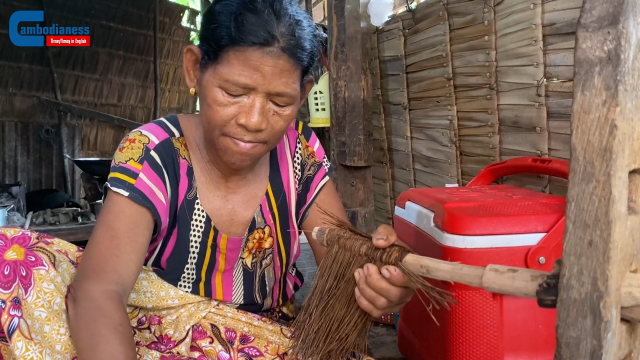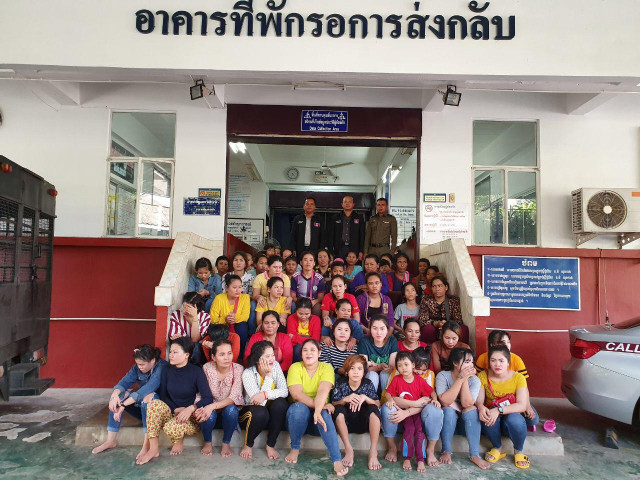Traditional Palm Tree Sheath Brooms: Green, Affordable and Durable

- By Nhek Sreyleak
- and Ky Chamna
- September 26, 2022 2:22 PM
SIEM REAP - Wandering through the nutrient-rich and culture-rich land of Angkor, the livelihood of the local villagers is still pretty much being preserved. One could witness, feel and somehow comprehend what the atmosphere could have looked like one hundred or two hundred years ago. Wooden countryside houses surrounded by tangling fast-growing trees scatter along the rice paddies soaking wet by the heavy tropical rain and the absence of the scorching sun. Herds of water buffaloes bathe in the flood plains as they enjoy the small vegetation for their afternoon snack. Muddy red soil binds to the tires like glue which is almost impossible for small cars to get through.
Once in a while, small temples and tiny ancient shrines appear behind a wall of thickly-grown trees, hidden from sight and undisturbed by the population. As one travels deeper into the village, groups of houses unite to form small communities with medium-size pagodas and small-size schools nearby.
As lunch is served and the sky is cloaked with increasingly darker clouds, the cooler wind woos some villagers to take a small nap on their bamboo bed or their hummock. If not, apart from traveling to their rice paddies and conducting agricultural activities, some locals also implement craftsmanship as a way to bring more earnings. Their commitment and creativity brought additional income to their families as they transform raw materials surrounding their living space into something practical and useful for daily living.
In the village of Doun Kaev, Puok district, Siem Reap province, Mom Laen is one of the hustling women who craft raw materials into products. Specifically, this elderly lady traditionally makes use of palm tree sheath which is an abundant natural resource around her village. Through her free time and a few processes later, the palm tree sheath can be braided into hand-sized household brooms in which she often sells it at the local market.
After a satisfying lunch, when some of her family members already went to take a short nap, the elderly lady did not rest right away. Instead, Mom Laen is sitting next to a pile of dried palm tree sheath inside the comfort of her wooden and bamboo huts as her hands quickly tie them into specific patterns before it can become a properly-functioning broom. Well-known for their versatility and inexpensiveness, what most people do not really know is that these brooms are also incredibly time-consuming to make. While Mom Laen is sitting inside and braiding the broom, outside is her daughter-in-law hammering the sheath vigorously breaking them into string pieces.
_1664177153.png)
Originally, the fiber-like sheath actually comes in larger and heavy block pieces. The raw material has to be extensively wetted, broken down using hammer and manual force, sun-dried and separated into more confined fibers before they can be braided into brooms. So, why does the sheath have to be wetted for quite some time underground? Hammering them directly after they are freshly cut can cause the material to shatter since they are quite crispy.
Therefore, Mom Laen’s daughter-in-law has to first bury the sheath slightly underground and generously apply water in order to soften them. The thicker sheath would need around 45 days for them to be ready while thinner ones only need about 15 days.
Once it is softened or drenched enough, the sheath will be hammered and pieces of fibers will appear after a few sets of hits. More importantly, the main hammer in use must be made from softer materials like wood. Metal hammer is included as well but only for the first few hits so that the harder outside layers can be broken down much easier. Without the softer wooden hammer, constant metal hammering would be too strong for the sheath and it can break apart the fiber making them impractical for braiding.
Later on, after the sheaths are beaten, they must be fully dried in the sun for two days. Then, they will be submerged in the water again before combing thoroughly with an iron comb made from nails. In the final stage, we will see dried, individual, and string-like materials that will be delivered to Mom Laen as she prepares to twist into brooms.
_1664177243.png)
Naturally, the fibers will not be of equal length. Some might be smaller or longer than others. Hence, the shorter ones will be braided into brushes while the longer ones will be used to secure the braiding to the wooden handle.
After the materials are all ready, Mom Laen continued by braiding the dried fibers. She attaches the broomstick, which is about 30 centimeters in length, to a wooden stabilizer that arrives at a comfortable height in front of Mom Laen. She then starts crisscrossing the fiber one on the top and the other on the bottom, creating a secured pattern as she continues finishing it.
On average, it would take less than a week to make a hundred brooms. But if you have fewer people working, it might take up to a week or so to achieve that number. Moreover, with 100 brooms, Mom Laen will earn 100,000 riels or approximately 25 USD. Although this amount of money is unable to meet her family daily needs, it definitely is helpful for smaller expenses around the house.
Despite the small fee, Mom Laen expresses her happiness in her work. She would like to continue braiding brooms because it is neither demanding nor extremely tiring compared to farming or raising animals. Instead, it is a perfect side hustle to keep her busy during her free time and provide extra cash along the way as well.
It is true that the price is quite unfair considering the effort to braid and the time to prepare the raw materials. However, there seem to be limited options for Mom Laen in this case.
“I do not think 1000 riels per broom is a reasonable price. Frankly, I would also like for the price to increase to 1500 riels, at least, but it will be too expensive for the market. So, I have no choice but to settle at this cost. Although it is not much to sustain the daily living of my family, it is an additional help and a hobby for me.”
Both the mother and her daughter-in-law have been practicing this business for a while now. And even though the competition is high as the people prefer using plastic brooms, they both still express a positive mindset toward the traditional ones.
“These traditional brooms are still popular regardless of the wide selections today. I never had trouble selling them, every time I went to the market, all of my brooms were bought instantly. The middlemen also prefer to have varieties of options ranging from plastics to traditional brooms like this ones to satisfy the customers' needs or sell to retailers… Aside from the high-demand inside the country, the palm tree sheaths brooms are popular cross border as well like in Thailand”, said Mom Laen’s daughter-in-law.
_1664177360.png)
Together, both the mother and the daughter-in-law help one another in this small business. After finishing 100 or more brooms, the middlemen will come directly to their house to buy it all. Otherwise, Mom Laen’s daughter-in-law would sell the brooms on her bicycle at the markets in Siem Reap province.
This small business did not help them much as the fee is quite limited and the effort is high. But, it is enough to get by for tiny expenses around the house and it is a better option to fill in the void of time. Based on the status quo, the traditional brooms are popular already but it could have been more widely used. These brooms, although they look simple and modest, are durable. One could last up to months if used properly. But the important part is, they are organic and biodegradable. After the strings are shredded apart and no longer can be used, it can be returned to the dirt or soil and none is harmful to the environment. There are no micro-plastic particles which can get into the food-chain.
Potentially, these brooms are a huge help to the environment and sustainable living as well as a promotion toward the livelihood of local traditional craftsmanship. Supporting the palm tree sheath brooms is both helping the environment to be greener and the smaller businesses like Mom Laen and her daughter-in-law to continue making these traditional brooms.
Originally written in Khmer for ThmeyThmey25, this story was translated by Song Daphea for Cambodianess.















